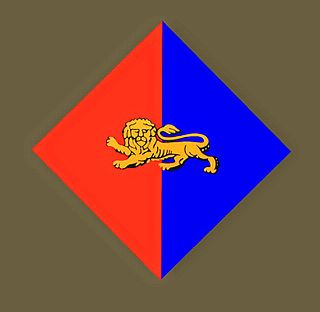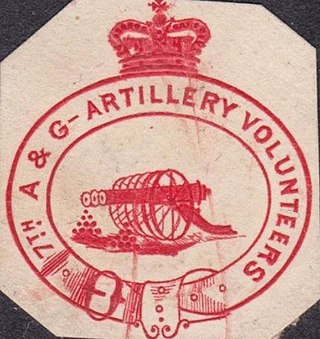The Sussex Yeomanry is a yeomanry regiment of the British Army dating from 1794. It was initially formed when there was a threat of French invasion during the Napoleonic Wars. After being reformed in the Second Boer War, it served in the First World War and the Second World War, when it served in the East African Campaign and the Siege of Tobruk. The lineage is maintained by 1 Field Troop, 579 Field Squadron (EOD), part of 101 (London) Engineer Regiment (Volunteers).

The 56th Anti-Tank Regiment was a Territorial Army unit of the British Army's Royal Artillery (RA), which converted from the 4th Battalion, King's Own Royal Regiment (Lancaster). During the Second World War, it first served with the 42nd Division in the Battle of France and Dunkirk evacuation in May–June 1940. In 1942, it was sent to join the 70th Infantry Division in India, where it was converted into a Light Anti-Aircraft/Anti-Tank Regiment. In this guise, it served in the Burma Campaign, mainly with the 5th Indian Infantry Division. It reconverted to the anti-tank role in late 1944 and in June 1945 it returned to India as a training unit. It continued serving in the TA postwar until 1961, when it re-merged into the King's Own.
The 1st Lanarkshire Artillery Volunteers were formed in 1859 as a response to a French invasion threat. Its units fought at Gallipoli and in Palestine during World War I, and in Normandy and North West Europe during World War II. It continued in the postwar Territorial Army until 1961.
The 2nd Kent Artillery Volunteers, later 4th London Brigade, Royal Field Artillery, popularly known as the Lewisham Gunners, was a volunteer unit of the British Army from 1860 until 1967. Initially raised in suburban West Kent, its recruiting area was later incorporated within the County of London. It provided two active service units in each of the World Wars, operating as far afield as Sicily, Burma and Madagascar, and later provided an airborne unit in the Territorial Army of the 1950s.

The 1st Midlothian Artillery Volunteer Corps was formed in 1859 as a response to a French invasion threat. Originally it served as garrison and heavy artillery but transferred to the Territorial Force (TF) in 1908 as field artillery, in which role it served through both World Wars. In the First World War, it fought on the Western Front with 51st (Highland) Division. In the Second World War, it briefly saw service in France after the Dunkirk evacuation and later served with the Eighth Army in North Africa and Italy. Its wartime duplicate regiment served with distinction in the Burma campaign. Postwar, the regiment continued in existence until amalgamation in 1967.

The 2nd Cinque Ports Artillery Volunteers was a part-time unit of the British Army's Royal Artillery from 1890 to 1955. Raised as coastal defence artillery, it later served as field artillery in Mesopotamia during the First World War and in the Battle of France and Second Battle of El Alamein during the Second World War. Its successor units later operated as medium artillery in North West Europe, and as jungle artillery in Burma. Postwar, it became an anti-aircraft unit.

The 1st Sussex Artillery Volunteers was a part-time unit of the British Army's Royal Artillery from 1859 to 1961. Raised as coastal defence artillery, the unit later served as field artillery in Mesopotamia during World War I, and in North Africa, Sicily, Italy and North West Europe during World War II. It carried out a number of roles in the postwar Territorial Army.

The 1st Ayrshire and Galloway Artillery Volunteer Corps was formed in 1859 as a response to a French invasion threat. It transferred to the Territorial Force (TF) in 1908 and its successor units fought with the 52nd (Lowland) Infantry Division in Palestine during World War I, and in North West Europe and Burma during World War II. It continued in the Territorial Army (TA) until amalgamation in 1967.

The 1st Glamorganshire Artillery Volunteers was formed in 1859 in response to a French invasion threat. Raised as a coast artillery unit, it later became part of the Royal Field Artillery in the Territorial Force and served during both World Wars until amalgamated in 1961.

79th (Lowland) Field Regiment was a Royal Artillery (RA) unit of Britain's part-time Territorial Army (TA) during World War II. It was descended from the 1st Ayrshire and Galloway Artillery Volunteers, first raised in Scotland in 1859. It served in Home Forces for most of the war, undergoing training in mountain warfare and air-portable operations before eventually going into action at sea level in the Battle of the Scheldt. It then took part in the fighting in the Rhineland, and then the drive to Bremen. It was reformed in the postwar TA, and continued until 1967.

130th (Lowland) Field Regiment was a Royal Artillery (RA) unit of Britain's part-time Territorial Army (TA) created just before World War II. It was formed from part of 79th (Lowland) Field Regiment, Royal Artillery, itself descended from the 1st Ayrshire and Galloway Artillery Volunteers, first raised in Scotland in 1859. After serving in home defence the new regiment was sent to India where it participated in the First and Second Arakan Offensives, and then in the Burma campaign (1944–1945). It was reformed in the postwar TA and continued in various roles until 1955.

The 8th London (Howitzer) Brigade, Royal Field Artillery was a new unit formed when Britain's Territorial Force was created in 1908. Its origin lay in Artillery Volunteer Corps formed in the 1860s in Plumstead, Kent, later incorporated into London. Together with its wartime duplicate the brigade served during the First World War on the Western Front, at Salonika and in Palestine where it was the first British unit to enter Jerusalem. It again formed two units for service in the Second World War, one of which saw extensive action in France, North Africa, and Italy, while its duplicate was captured at the Fall of Singapore. Its successor unit continues in the Army Reserve today.

The 3rd Lancashire Artillery Volunteers was a unit of Britain's part-time Volunteer Force recruited from Blackburn and the surrounding area in 1860. It became a brigade of the Royal Field Artillery in the Territorial Force in 1908, and served through the First World War with the 42nd Division at Gallipoli, in Egypt and on the Western Front. Its second line unit also served on the Western Front in 1917–18. During the Second World War, its batteries operated in the light anti-aircraft role in Norway, France, Greece, Crete, North Africa and Italy. It was reformed postwar, but disappeared in a merger in 1955.

The 52nd Light Anti-Aircraft Regiment, was a Royal Artillery (RA) air defence unit of Britain's part-time Territorial Army (TA) converted from a field artillery unit just before the outbreak of World War II. It served in the Battle of France, shooting down a large number of aircraft before being evacuated from Dunkirk. It was then sent to the Mediterranean, where detached batteries were destroyed in the fighting in Greece and Crete. The reformed regiment then took part in the defence of the Suez Canal and later in the Italian Campaign. It continued in the postwar TA until 1955 when it merged with other units in Lancashire.

The 56th Light Anti-Aircraft Regiment, Royal Artillery, was a Royal Artillery (RA) air defence unit of Britain's part-time Territorial Army (TA) raised as a duplicate unit just before the outbreak of the Second World War. It served in the Norwegian Campaign and then joined 8th Armoured Division. It was sent to Egypt and participated in the Second Battle of El Alamein and the subsequent pursuit across North Africa. It then fought in the Italian Campaign, including defending the Salerno and Anzio beachheads. It often operated under US command, on one occasion in an anti-tank role. The regiment reformed as heavy AA artillery in the postwar TA and continued until 1955 when it merged with other units in Lancashire.

The Manchester Artillery is a Volunteer unit of the British Army first raised in the City of Manchester in 1860, whose successors continue to serve in the Army Reserve today. It became a brigade of the Royal Field Artillery in the Territorial Force in 1908, and in World War I it served in Egypt in 1915–17 before being broken up. Its second line unit went to the Western Front in 1917, seeing action at Ypres, against the German Spring Offensive, and leading the pursuit in the Allies' victorious Hundred Days Offensive. Just before World War II the Manchester Artillery again formed a duplicate. While the parent regiment served in the Battle of France including the Dunkirk evacuation, and later in the Middle East and the Italian campaign, its duplicate fought in Normandy and North West Europe. Both regiments were reformed postwar, but after a number of amalgamations they and several other Manchester-based units were reduced into 209 Battery in the present-day Army Reserve.

The Bolton Artillery, under various titles, has been a Volunteer unit of the British Army based in Bolton, Lancashire, since 1889. In the First World War it served in Egypt and Gallipoli in 1915–17, and then on the Western Front for the rest of the war, including Passchendaele, the German Spring Offensive and the Allied Hundred Days Offensive. Just before the outbreak of the Second World War the regiment formed a duplicate unit. The parent regiment served in the Battle of France and was evacuated from Dunkirk. Both regiments served at the Battle of Alamein and in the Italian campaign, while one of the regiments was involved in the intervention in Yugoslavia. The regiment was reformed postwar, and after a number of mergers its successors continue to serve in today's Army Reserve.

53rd (Bolton) Field Regiment was a Royal Artillery (RA) unit of Britain's part-time Territorial Army (TA) during World War II. It was descended from the Bolton Artillery, first formed in the Lancashire town of Bolton in 1889. It served in the Battle of France, at the end of which its personnel were evacuated from Dunkirk. It was then sent to the Middle East where it joined 8th Indian Division and fought with this division in the Italian Campaign. It was reformed in the postwar TA, and its successor unit continues as a battery in the present day Army Reserve

111th (Bolton) Field Regiment was a Royal Artillery (RA) unit of Britain's part-time Territorial Army (TA) formed just before World War II. It was descended from the Bolton Artillery, first formed in the Lancashire town of Bolton in 1889. After serving in home defence it was sent to the Middle East where it participated in the Second Battle of El Alamein and the Battle of Mareth. It served in the Italian Campaign, and was then transferred to Yugoslavia, fighting alongside Tito's Partisans. The regiment was disbanded at the end of the war.

80th Field Regiment was a Royal Artillery (RA) unit of Britain's part-time Territorial Army (TA) during World War II. It was descended from the 1st Lanarkshire Artillery Volunteers, first raised in Scotland in 1859. It served in Home Forces for most of the war, undergoing training in mountain warfare and air-portable operations before eventually going into action at sea level in the Battle of the Scheldt. It then took part in the fighting in the Rhineland, and then the drive to Bremen. It was reformed in the postwar TA, and continued until 1961.













